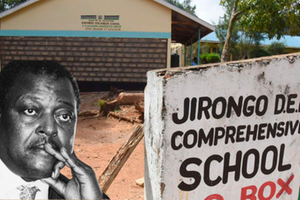State should create a database of GBV safe houses

A GBV safe house in Mokowe, Lamu County, after it was opened on July 22, 2022. The government should create a database of all safe houses and standardise services.
What you need to know:
- The clamour to establish more shelters demonstrates their necessity; but it is also an ugly reminder of our failure to prevent GBV.
- The right to life is fundamental, hence the responsibility for shelters lies with the government.
Whether called shelters, safe spaces or half-houses, their essential purpose is to provide sanctuary for survivors of gender-based violence (GBV).
These structures, largely established by non-profit organisations, provide temporary housing for brutalised women away from the source of affliction.
The original Protection against Domestic Violence Bill in the 11th parliament required the state to establish shelters for victims of domestic violence.
However, the clause was deleted based on an argument by men in the Justice and Legal Affairs Committee that it was administrative rather than legal. This implies that GBV survivors cannot hold the state accountable for lack of such facilities.
Nevertheless, the idea is today generously scattered in county government plans. Nairobi County already has a shelter in Kayole and is putting up another one in Westlands with financial assistance from the National Government Affirmative Action Fund.
GBV war failure
The clamour to establish more shelters demonstrates their necessity; but it is also an ugly reminder of our failure to prevent GBV.
At a workshop held on June 29, for the Nairobi County Gender Sector Working Group to disseminate findings of two studies by Kenyatta University Women’s Economic Empowerment Hub (SGBV Team) on the effectiveness of programmes providing services to survivors of GBV, a vibrant discussion emerged on the viability of shelters.
One participant whose organisation runs such spaces referred to them as a “big financial hole” that attracts little support even from traditional donors.
This observation can be appreciated by looking at what goes into a shelter.
There must be a physical structure whose size will depend on the anticipated number of occupants at any one time. It must be furnished with the basics and accessible to utilities and eating services.
There must be some staffing, primarily for security and welfare. The shelter must be located in a discreet place so as not to attract undue public attention, threats and stigma against occupants.
The costs must be met regardless of the number of occupants, against the backdrop that the services are free. Shelters are also alienating in the context that the beneficiaries are separated from children, work and the normal social environment to which they are eager to return.
A number of other operational issues about shelters arise. What is the optimum number of occupants? For how long can one stay in a shelter? How can the desires of survivors who wish to leave earlier be respected against the imperative of protection from further harm? What happens to those with nowhere to go after the expiry of the prescribed time?
How about occupants with special needs, such as mothers with children and women with mental illness? How are occupants protected from shelter staff, fellow survivors and other parties?
A fundamental issue is about the legal status of the shelters. Kenya currently has no law or official regulations guarding the establishment, registration, management and operation of such facilities.
In simple terms, they operate in a vacuum. Who then are they accountable to? What risks come along with this situation? Is there any danger that shelters can be used for illegal purposes? Are the occupants insured against any risk? Who takes responsibility for any eventualities there?
The simple answer is that the good Samaritans running the shelters are doing so at a very high risk.
Guidelines
A 2019 manual co-produced by the Embassy of Finland, UK Aid and the Swedish Embassy, in collaboration with UN Women and the then Ministry of Public Service, Youth and Gender, is the closest one comes to concerning guidelines for shelters.
Titled Strengthening safe and protective spaces for women, girls and children in Kenya, the manual recognises that “there are no national guidelines to inform the establishment and operations of safe and protective spaces” in addition to the fact that “most of them are run by civil society organisations and depend on donor funding,” hence “tend to be short-term and unsustainable”.
Moreover, “the services offered… are not always comprehensive” and the “spaces often do not adhere to international standards and principles.”
The purpose of the safe spaces is to save lives. Given that the right to life is fundamental, the manual is correct in stating that the responsibility for GBV shelters lies with the state.
But to what extent is the welfare of GBV survivors a government priority? Is there a strategy to ensure that shelters are not only established physically but also adequately resourced? Beyond this, what is the game plan to eradicate GBV?
Needless to say, the government should establish a database of existing shelters, their proprietors, and the variety and quality of services offered. It must also establish the legal and operational frameworks, which will clarify their domicile, guide actors and standardise the services.
The writer is an international gender and development consultant and scholar ([email protected]).




